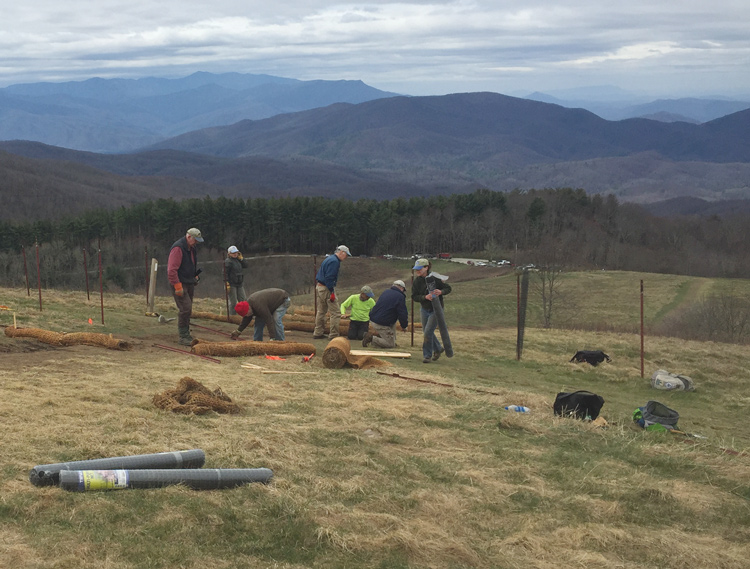![]() trailhead
trailhead
There are two main origins of open areas along the A.T.: cultural and ecological. Most cultural open areas are relicts of an agricultural past, such as the open areas in the bucolic landscape surrounding Tyringham, Massachusetts. This part of the Berkshires was first settled in 1735 as an agricultural community and contains some of the largest open meadows within the A.T. corridor. These open areas are managed as priority habitat for grassland bird species like the bobolink and for pollinators, but also for grazing livestock to maintain the historical context of the area.
One of the most notable ecological open area types along the A.T. are the extremely rare and critically imperiled Southern Appalachian Grassy Balds. These grassy balds are relicts of the last ice age and exist only in Tennessee, North Carolina, and Virginia. The most commonly accepted theory on the origin of these balds is: as the earth warmed, the climatic treeline disappeared in the Southern Appalachians and woody vegetative growth began. Many of the prehistoric large grazers went extinct due to factors related to the warming climate, others like elk were hunted to regional extinctions. As these events played out, many of these balds slowly disappeared. However, some of the best remaining examples still exist along the A.T. While some of these sites may have more recently been maintained by Native Americans with fire, many were subsequently or additionally grazed with livestock. The most well-known occurrences of Southern Appalachian Grassy Balds exist along the Roan Mountain Massif. According to U.S. Forest Service botanist Gary Kauffman, the grassy balds of the Roan Highlands have lost about three quarters of their former range due to the encroachment of trees, shrubs, and invasive plants. Today, these balds are being maintained and restored with machinery by the Appalachian Trail Conservancy (ATC), Trail clubs, partner agencies and organizations, and volunteers.

The open areas programming along the A.T. is continuing to evolve and grow through ongoing scientific research, expanding partnerships, robust support from the Appalachian National Scenic Trail office, and the work of Trail clubs and volunteers. The ATC will continue to manage these open areas to reclaim and preserve the iconic views along the A.T., while considering their ecological role in the greater landscape.
![]() trailhead
trailhead
There are two main origins of open areas along the A.T.: cultural and ecological. Most cultural open areas are relicts of an agricultural past, such as the open areas in the bucolic landscape surrounding Tyringham, Massachusetts. This part of the Berkshires was first settled in 1735 as an agricultural community and contains some of the largest open meadows within the A.T. corridor. These open areas are managed as priority habitat for grassland bird species like the bobolink and for pollinators, but also for grazing livestock to maintain the historical context of the area.
One of the most notable ecological open area types along the A.T. are the extremely rare and critically imperiled Southern Appalachian Grassy Balds. These grassy balds are relicts of the last ice age and exist only in Tennessee, North Carolina, and Virginia. The most commonly accepted theory on the origin of these balds is: as the earth warmed, the climatic treeline disappeared in the Southern Appalachians and woody vegetative growth began. Many of the prehistoric large grazers went extinct due to factors related to the warming climate, others like elk were hunted to regional extinctions. As these events played out, many of these balds slowly disappeared. However, some of the best remaining examples still exist along the A.T. While some of these sites may have more recently been maintained by Native Americans with fire, many were subsequently or additionally grazed with livestock. The most well-known occurrences of Southern Appalachian Grassy Balds exist along the Roan Mountain Massif. According to U.S. Forest Service botanist Gary Kauffman, the grassy balds of the Roan Highlands have lost about three quarters of their former range due to the encroachment of trees, shrubs, and invasive plants. Today, these balds are being maintained and restored with machinery by the Appalachian Trail Conservancy (ATC), Trail clubs, partner agencies and organizations, and volunteers.

The open areas programming along the A.T. is continuing to evolve and grow through ongoing scientific research, expanding partnerships, robust support from the Appalachian National Scenic Trail office, and the work of Trail clubs and volunteers. The ATC will continue to manage these open areas to reclaim and preserve the iconic views along the A.T., while considering their ecological role in the greater landscape.